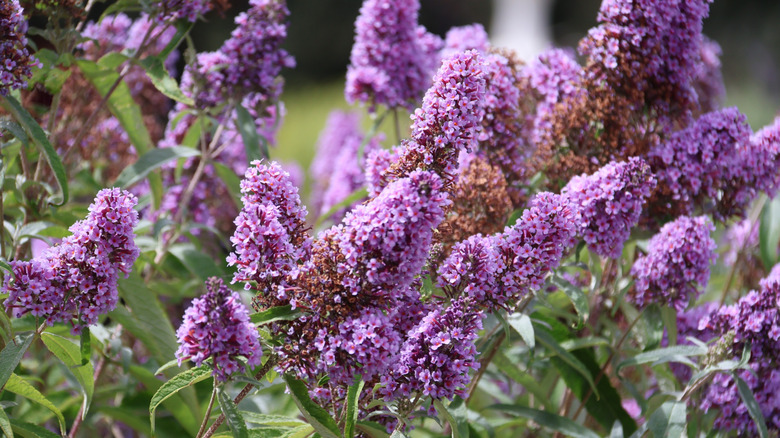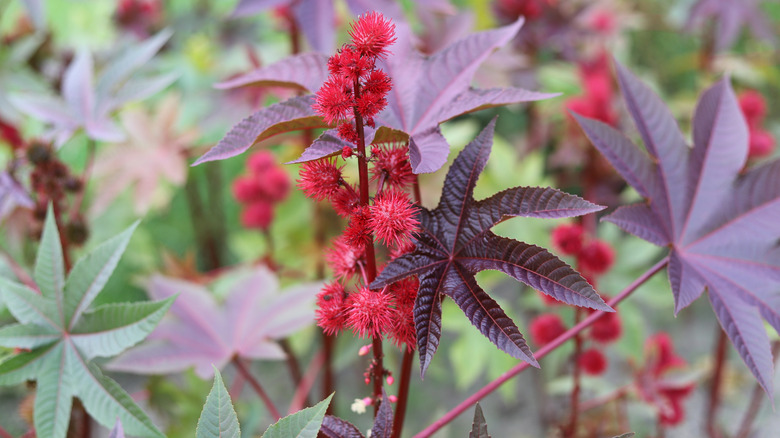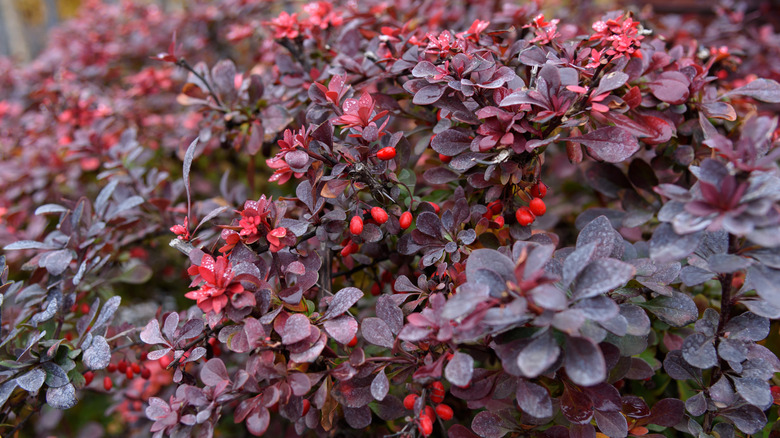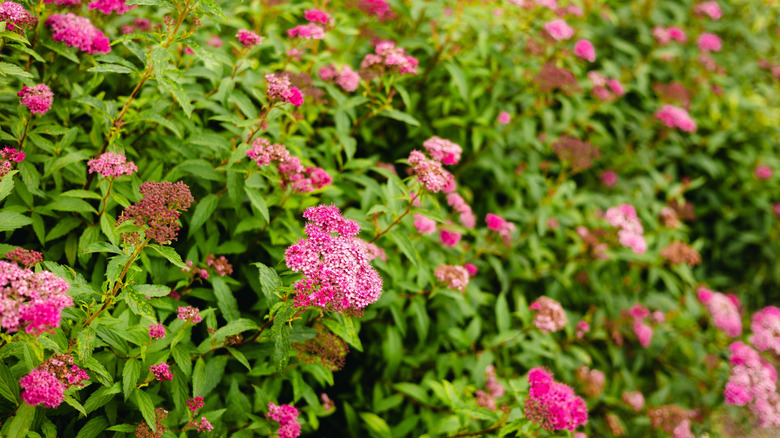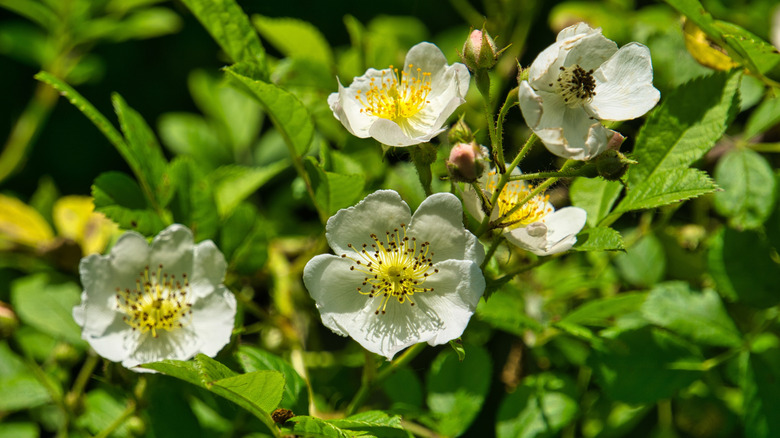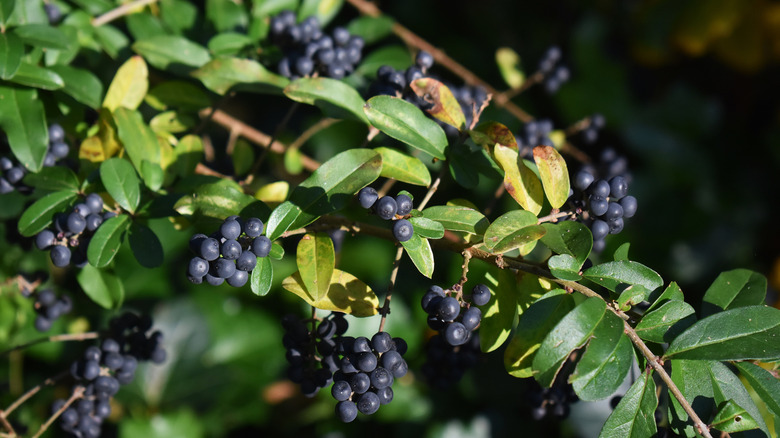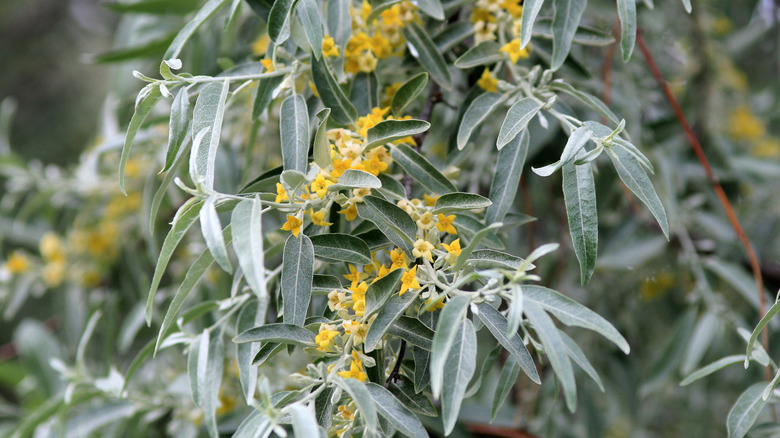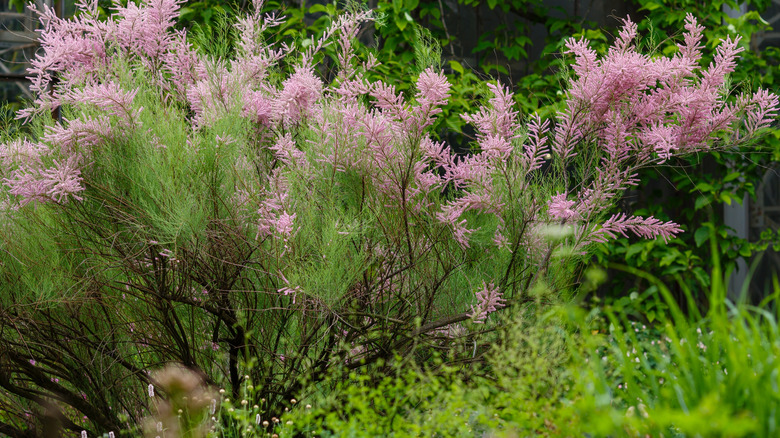13 Invasive Shrubs You Should Never Plant In Your Yard
It's an awkward situation for gardeners — admiring a beautiful plant in our yards when someone tells us it's an invasive species. Ouch. Invasive species are by definition non-native, but that's not the only qualifier. They also cause harm. Since shrubs are important features in landscaping, gardeners should take time to learn which types are invasive and what problems they can cause. For instance, some of the invasive shrubs you should never plant in your yard include nandina, butterfly bush, and privet. Choosing non-invasive species isn't just a matter of doing the right thing for your conscience – depending on where you live, it can be illegal to buy, sell, or propagate certain invasive shrubs.
Invasive shrubs cause damage to ecosystems by displacing native plants and providing less food for local animals such as butterflies, bees, and birds. Plus, they tend to spread quickly and can turn your yard — or surrounding areas — into a weedy mess. When determining whether a plant is problematic in these ways, researching it by its scientific or common name can help, but there are also traits that give invasive plants away, such as preventing other plants from growing nearby or showing up without being planted. The following selections are invasive species in the U.S. that everyone should be aware of so they can make better choices for their yards. When choosing replacements for these invasives, pick native alternatives when possible.
Autumn olive
Also known as silverberry, autumn olive (Elaeagnus umbellata) was intentionally planted in the U.S. in the 19th century to help control soil erosion and has since spread throughout the country. This invasive shrub can reach up to 30 feet tall and has silvery leaves, creamy flowers, and red fruit. Seeds spread when birds eat their red fruits, but the fruits don't offer any nutritional value. Never plant invasive autumn olive in your yard. The best alternative to autumn olive will depend on where you live, but some options include wild plum (Prunus americana) and American hazelnut (Corylus americana).
Brazilian peppertree
Brazilian peppertree (Schinus terebinthifolius) is a broadleaf evergreen shrub that produces clusters of small, red fruit and grows in dense stands reaching 30 feet tall. Also known as Florida holly, Brazilian peppertree is an invasive shrub in Florida, Texas, and California. It grows quickly and is thought to inhibit competing plants by producing allelopathic chemicals. Although this plant was introduced as an ornamental, you should never plant it in your yard. There are native alternatives to Brazilian peppertree — consider broadleaf evergreens with red berries, such as Toyon (Heteromeles arbutifolia) or Cassine holly (Ilex cassine).
Butterfly bush
Butterfly bush (Buddleja davidii) is an invasive shrub that reaches up to 10 feet tall and has arching sprays of purple, white, or pink flowers. Well-intentioned gardeners grow this shrub to feed pollinators, but the bitter truth about butterfly bush is that it's not good at feeding baby butterflies — that's to say, caterpillars. And since it doesn't feed caterpillars, it doesn't help birds either. Never plant this shrub, which is invasive in many places in the U.S. Instead, grow natives in your yard, such as beautyberry (Callicarpa americana), butterflyweed (Asclepias tuberosa), or Virginia sweetspire (Itea virginica).
Burning bush
Burning bush (Euonymus alatus) is one of the worst invasive plants that you should avoid at all costs. Also called winged euonymus, this shrub has red berries, reaches 20 feet tall and wide, and is identifiable by its ridged bark. Grown as an ornamental for its bright fall color, burning bush is considered invasive in the eastern and midwestern U.S. because it easily spreads into surrounding areas via its seeds. Grow native alternatives instead, such as red chokeberry (Aronia arbutifolia), fothergilla (Fothergilla spp.), or common ninebark (Physocarpus opulifolius).
Castor bean
With large, palm-shaped leaves and spiky seed pods, castor bean (Ricinus communis) is a highly toxic shrub that can reach 10 feet tall as an annual. Castor bean is considered an invasive shrub in the U.S., so you should never plant it in your yard. This tropical-looking plant can displace more desirable vegetation and can deposit its poison into the ecosystem. Plus, the seeds it produces can be fatal to humans in very low doses. Fatsia (Fatsia japonica) is a non-native alternative with similar leaves but without the invasive tendencies.
English holly
Growing as a shrub or small tree, English holly (Ilex aquifolium) is an ornamental that has become invasive in parts of the United States. This evergreen has spiny leaves and bears bright red berries, which are eaten by birds and spread into forests where these 30-foot-tall shrubs displace native species. Never plant English holly in your yard if you live in the Pacific Northwest, New Jersey, or Virginia, where it's considered an invasive shrub. There are numerous native alternatives to English holly, including American holly (Ilex opaca), yaupon holly (Ilex vomitoria), and Oregon grape (Mahonia aquifolium).
Japanese barberry
Japanese barberry (Berberis thunbergii) is an ornamental, compact shrub that reaches 6 feet tall, has rounded leaves, red berries, and desirable fall color. But you'll want to think twice before planting Japanese barberry in your garden since it spreads by its roots and through the dispersal of its berries. Japanese barberry is an invasive shrub in numerous states in the eastern and midwestern U.S., so if you live in those regions, never grow it in your yard. Instead, choose from shrubs like common ninebark (Physocarpus opulifolius), sweet pepperbush (Clethra alnifolia), or New Jersey tea (Ceanothus americanus).
Japanese spiraea
Japanese spiraea (Spiraea japonica) is an ornamental shrub that reaches up to 6 feet tall and has clusters of white or pink flowers and toothed leaves. If you live in the eastern U.S., where it's considered an invasive shrub in several states, you should never plant it in your yard. Japanese spiraea can spread quickly via both seeds and suckering. There are beautiful native plants to grow instead of invasive spirea, such as mountain laurel (Kalmia latifolia) and Virginia sweetspire (Itea virginica).
Multiflora rose
Also known as rambler roses, multiflora roses (Rosa multiflora) can reach 15 feet tall and have white or pink blooms that give way to red rosehips containing the plant's seeds. These roses were introduced as rootstock for ornamental roses but have since become unwanted, spreading to form large thickets that disrupt both agricultural lands and native plant ecosystems alike. Multiflora roses are now considered invasive shrubs in many states in the U.S., so never grow one in your yard. There are excellent native alternatives for this shrub, such as Carolina rose (Rosa carolina) and black chokeberry (Aronia melanocarpa).
Nandina
Nandina (Nandina domestica), also called sacred bamboo, is a 3- to 8-foot-tall shrub that is frequently used in foundation plantings in front of homes and is appreciated for its bright red berries and beautiful fall foliage. However, nandinas easily escape from cultivation when birds eat their berries. This invasive shrub is particularly problematic in the southeast U.S., and if you live there, you should never plant nandina in your yard. Instead, choose among natives such as strawberry bush (Euonymus americanus), inkberry (Ilex glabra), or southern arrowwood (Viburnum dentatum).
Privet
Privets (Ligustrum spp.) are fast-spreading, invasive privacy plants introduced to the U.S. as hedges. There are many types of privets, and some commonly encountered types produce leathery leaves, bear bluish-black colored berries, and reach up to 15 feet tall. Privets spread by seeds into forests and form dense thickets, preventing other plants from growing. Privets are considered invasive shrubs in several states in the midwestern and eastern U.S., so you should never plant them in your yard. Better native alternatives to privets include bayberry (Myrica cerifera), small magnolia (Magnolia virginiana), or mapleleaf viburnum (Viburnum acerifolium).
Russian olive
More common in the western U.S., Russian olives (Elaeagnus angustifolius) grow as shrubs or trees that can reach up to 20 feet tall. These non-native plants have silvery foliage, small yellow leaves, and yellow or brown fruits. You should never plant a Russian olive on purpose, as birds easily spread its seeds, and these invasive shrubs prevent native vegetation from surviving. Instead of Russian olive, choose U.S. natives like desert willow (Chilopsis linearis), American witchhazel (Hamamelis virginiana), or Texas persimmon (Diospyros texana).
Tamarisk
Tamarisk (Tamarix spp.), also known as salt cedar, is an invasive shrub that is particularly problematic in the western U.S, though it is invasive in the central U.S. as well. These plants have scale-like leaves and showy clusters of white or pink flowers, which prompted their introduction as ornamental species. Tamarisk creates a multitude of problems beyond crowding out native plants — it even causes drastic changes to the ecosystem by secreting salt. Never plant tamarisk in your yard; instead, opt for a native alternative, such as Apache plume (Fallugia paradoxa) or mesquite (Prosopis glandulosa).



